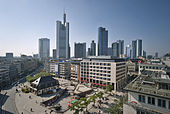Demographics of Germany

|
|
| Population | 82,175,700 (31 December 2015) |
|---|---|
| Growth rate |
|
| Birth rate | 9.0 births/1,000 population (2015) |
| Death rate | 11.3 deaths/1,000 population (2015) |
| Life expectancy | 81 years (2015) |
| • male | 79 years |
| • female | 83 years |
| Fertility rate | 1.50 children born/woman (2015) |
| Infant mortality rate | 3.46 deaths/1,000 live births (2014) |
| Net migration rate | 1.06 migrant(s)/1,000 population (2014) |
| Total | 0.97 male(s)/female (2015) |
| At birth | 1.06 male(s)/female |
| Under 15 | 1.05 male(s)/female |
| 15–64 years | 1.02 male(s)/female |
| 65 and over | 0.76 male(s)/female |
| Nationality | noun: German(s) adjective: German |
| Major ethnic | Germans |
| Spoken | German, others |
| Rank | City | Federal-State | Population | ||
|---|---|---|---|---|---|
| 1 | Berlin | Berlin | 3,421,829 | ||
| 2 | Hamburg | Hamburg | 1,746,342 | ||
| 3 | Munich | Bavaria | 1,407,836 | ||
| 4 | Cologne | North Rhine-Westphalia | 1,034,175 | ||
| 5 | Frankfurt am Main | Hesse | 701,350 | ||
| 6 | Stuttgart | Baden-Württemberg | 604,297 | ||
| 7 | Düsseldorf | North Rhine-Westphalia | 598,696 | ||
| 8 | Dortmund | North Rhine-Westphalia | 575,944 | ||
| 9 | Essen | North Rhine-Westphalia | 569,884 | ||
| 10 | Bremen | Bremen | 548,547 | ||
| 11 | Leipzig | Saxony | 531,562 | ||
| 12 | Dresden | Saxony | 530,754 | ||
| 13 | Hanover | Lower Saxony | 518,386 | ||
| 14 | Nuremberg | Bavaria | 498,876 | ||
| 15 | Duisburg | North Rhine-Westphalia | 486,855 | ||
| Source: Statistische Ämter des Bundes und der Länder (December 31, 2013) |
The demography of Germany is monitored by the Statistisches Bundesamt (Federal Statistical Office of Germany). According to the first census since the reunification, Germany's population was counted to be 80,219,695 on May 9, 2011, making it the 16th most populous country in the world. Until 2014, Germany's population has been characterized by zero or declining growth, with an aging population and smaller cohort of youths. The total fertility rate has been rated around 1.4 in 2010 (the highest value since 1990) and has in 2011 even been estimated at 1.6 after accounting for the fact that older women contribute more to the number of births than in previous statistic models, and total fertility rates increased in younger generations. In 2008 fertility was related to educational achievement (with the less educated women having more children than the educated ones). In 2011 this was no longer true for Eastern Germany where college educated women now had a somewhat higher fertility rate than the rest of the population. Persons who adhere to no religion have fewer children than Christians, and studies also found that among Christians the more conservative ones had more children than the more liberal ones.In vitro fertilisation is legal in Germany, with an age limit set at 40.
The United Nations Population Fund lists Germany as host to the second-highest number of international migrants worldwide, behind the US at number one. More than 16 million people are of foreign/immigrant descent (first and second generation, including mixed heritage and ethnic German repatriates and their descendants). 96.1% of those reside in western Germany and Berlin. About seven million of them are foreign residents, which is defined as those not having German citizenship. The largest ethnic group of non-German origin are the Turkish. Since the 1960s, West and later reunified Germany has been attracting migrants primarily from Southern and Eastern Europe as well as Turkey, many of whom (or their children) over time acquired German citizenship. While most of these migrations had an economic background, Germany has also been a prime destination for refugees from many developing countries, in part because its constitution long had a clause giving a 'right' to political asylum, but restrictions over the years have since made it less attractive.
...
Wikipedia






